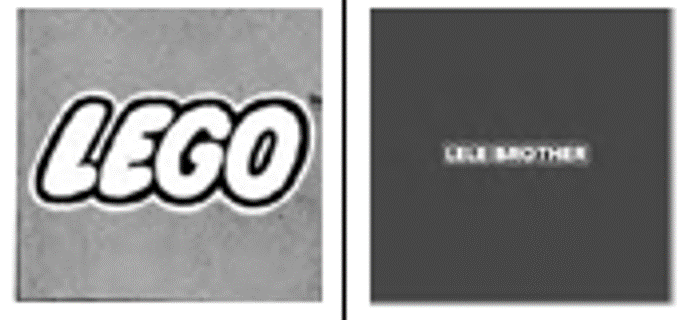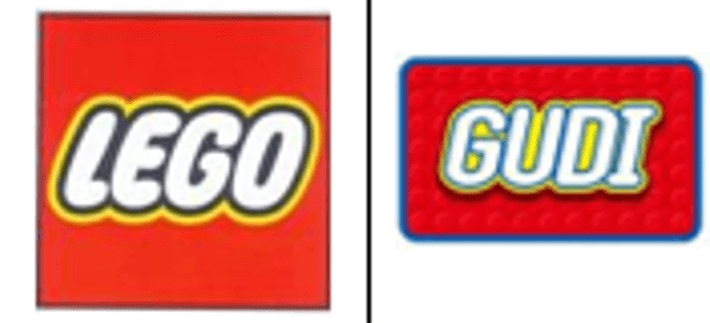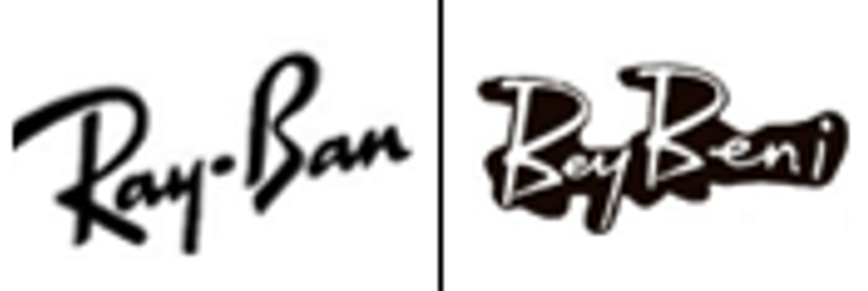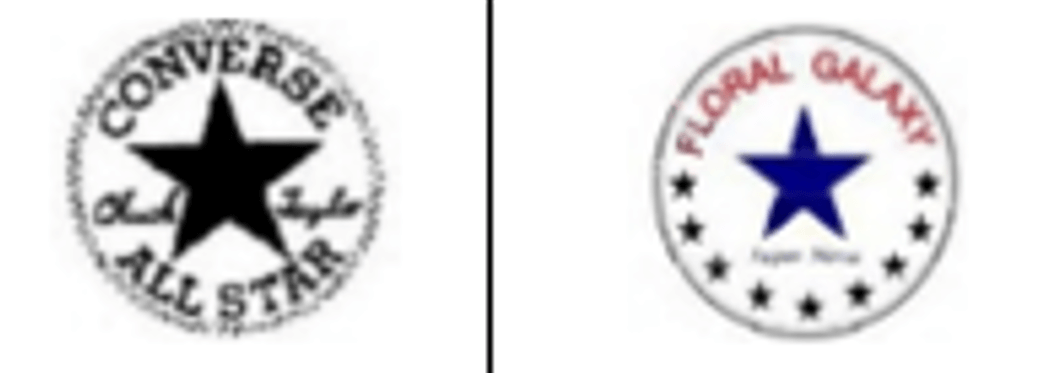Brand owners often struggle to protect their look-and-feel against free riders. A ten-year review of the EUIPO’s case-law shows that the look-and-feel of reputed marks – ranging from their logo, colour scheme to even their typical font – can be protected against imitations of this look-and-feel, even when the word elements completely differ. Hopefully, national courts follow suit. This article also contains some practical guidance on how to reach this protective status.
Protecting a brand’s look-and-feel – Relevant case-law of the EUIPO
On 29 September 2023 (B 3 159 692), the Opposition Division ruled that the semi-figurative trademark application LELE BROTHER took unfair advantage of the reputation of the semi-figurative LEGO mark. Indeed, even if the respective word elements did not bear much similarity, the EUIPO held that the specific shading of the contested sign imitated the color scheme of the reputed LEGO mark and that the contested games related goods presented a “more or less obvious” link to the goods marketed under this LEGO brand.

This recent decision is the latest of a long-standing trend in the EUIPO’s case-law. Over the last decade, the Board of Appeal has indeed annulled several first instance decisions to ensure the protection of the look-and-feel of reputed brands against trademarks imitating their overall visual arrangement. This outcome may come as a surprise to some since the conflicting signs have a rather low visual similarity due to the diverging word elements. However, the Board of Appeal has (almost) consistently been convinced by the risk of image transfer between the reputed goods and the contested goods in the mind of the relevant public on account of this mere imitation of the overall visual arrangement.
• On 15 May 2019 (R 2170/2018-5), the Board of Appeal annulled the decision rejecting Lego’s request for declaration of invalidity of the GUDI mark. Indeed, despite (i) a low degree of visual similarity between the conflicting signs, the Board of Appeal nonetheless deemed (ii) that there was a connection between, on the one hand, LEGO’s construction toys and, on the other hand, the contested games related goods in class 28, which (iii) allowed GUDI mark’s owner to take unfair advantage of the strong reputation of the LEGO brand.

• On 23 October 2018 (R 1900/2018-4), the Board of Appeal annulled the decision rejecting the opposition against the BEYBENI mark for a list of battery and power related goods in class 9. The Board of Appeal considered that (i) the conflicting signs were unquestionably similar in the overall impression conveyed and (ii) the RAYBAN brand enjoyed an exceptional reputation for sunglasses and spectacles frames in Spain, which (iii) despite the dissimilarity of the contested goods in class 9, lead to a serious risk that the relevant public could be attracted to these goods through an image transfer.

• On 9 November 2016 (R 1767/2015-5), the Board of Appeal annulled the decision rejecting All Star’s opposition against the FLORAL GALAXY mark covering washing related goods in class 3. Considering (i) the sign’s below average visual similarity and their conceptual similarity due to the stars, the Board of Appeal held that (ii) the public would make a link between the contested washing related goods and All Star’s shoes that were said to “get dirty” in a Converse campaign, which (iii) allowed the applicant to take unfair advantage of this brand’s repute for shoes in class 25.

By contrast, on 26 February 2018 (R 825/2017-2), the Board of Appeal confirmed the first instance decision rejecting BMW’s request for declaration of invalidity of the BLAUKREUZ WHEELS mark registered for vehicles in class 12 and services of advertising and marketing in class 35. The plea of likelihood of confusion was rejected because, even if the goods at stake were identical in class 12, the conflicting signs’ low visual similarity was deemed insufficient to mislead the relevant public, whose degree of attention was high. The plea of prejudice to the reputation of BMW’s brand suffered the same fate: indeed, despite the high repute of the BMW mark for motor vehicles in class 12, these goods were considered too dissimilar to the services in class 35 covered by the disputed mark to create a link in the mind of the relevant public.

While this decision may seem harsh considering the Board of Appeal’s other case-law, its outcome could have been different (at least in part) if BMW had claimed a prejudice to its mark’s repute also in class 12, rather than only in class 35. In any event, this decision appears isolated considering the remainder of the Board of Appeal’s case-law. In recent years, the EUIPO’s lower case-law has aligned itself on the Board of Appeal’s case-law and also asserted its protective stance on trademarks with a well-established reputation:
• EUIPO (Opp.), 13 March 2023, Lego Juris / Fuzhou Tera Fund Plastic Products, B 3 150 352

• EUIPO (Opp.), 9 November 2022, Starbucks Corporation / Sevenhill Gida Sanayi Ve, B 3 151 893

• EUIPO (Can.), 30 March 2022, VF International SAGL / X, C 50 577

• EUIPO (Opp.), 15 May 2021, Cerveceria Modelo de Mexico / X, B 3 105 605

Proving a mark’s repute – Relevant means of evidence
In practice, the brand owner must prove that its earlier mark is well-known (i) for the covered goods and/or services (ii) in a substantial part of the EU territory (iii) by the filing/priority date of the contested mark.
To assess a mark’s repute, all the relevant facts of the case are taken into account, including in particular (i) the mark’s market share, (ii) the intensity, geographical extent and duration of its use and (iii) the size of the investment to promote it.
Relevant means of evidence include in particular the following:
• Must have:
o Market surveys and opinion polls showing the mark’s market share and level of brand awareness, based on a clear methodology and a sufficient sample of people;
o Brand rankings listing the mark in a high position;
o Press publications (general and specialised) mentioning the mark;
o Report on advertising strategy and expenditure per country in the last five years, with supporting materials (e.g., social media, catalogues, leaflets, billboards, etc.);
o Report on sales volumes and turnover per country in the last five years, with supporting materials (e.g., annual reports, company profiles, affidavits, etc.).
• Nice to have:
o Certification and awards from chambers of commerce or professional associations;
o Record of successful enforcement (e.g., national courts, IP offices, UDRP, etc.);
o Mention of the mark in dictionaries, with the “®” sign;
o Exploitation of the mark through licensing, merchandising and sponsoring;
o ESG commitments and investments in relation to the mark/branded products.
Tips & Tricks
- Start gathering proof of your brand’s reputation today – Providing adequate and sufficient proof of a mark’s repute may turn out to be a time-consuming endeavor. However, it is a necessary requirement (or, for certain, perhaps an evil one), as the burden of proof lies with the brand owner and will not be presumed by the EUIPO or other IP offices and Courts. Therefore, adopting an internal collection system and planning sufficiently ahead is recommended to ensure that the relevant proof can be provided timely in support of your action.
- Give priority to objective and independent evidence of your brand’s reputation – Information coming directly from the owner itself (e.g., internal reports, etc.) is treated with caution by the EUIPO, especially if it consists of unverified opinions or estimates. Relying on publications, rankings, opinion polls and market surveys conducted by independent professionals is therefore strongly advised. These are often expensive, but money well spent if one wants to reach such a protective status (with all of its related advantages).
- Show actual imitations of your look-and-feel on the disputed products – Even if the applicant’s intent is not a requirement to conclude to a risk of injury to a mark’s repute in proceedings before the EUIPO, a side-by-side comparison showing the applicant’s willingness to imitate your branded products is nonetheless deemed relevant by the EUIPO to corroborate such finding in practice.
Conclusion
This ten-year review of the EUIPO’s case-law on reputed marks has shown that, contrary to popular belief, their look-and-feel can be protected against imitations at certain conditions, starting with a solid file of exhibits proving the brand’s reputation. The fight against a me-too brand is not a lost cause if one does merely own trademark rights on a semi-figurative sign protecting a (different) word element in combination with its typical and reputed look-and-feel (e.g., logo, colour scheme, font, etc. – it is indeed not always possible to protect these figurative elements separately). When one considers the difficulty often encountered by brand owners in defending their look-and-feel against free riders, the EUIPO’s stance sets a welcome precedent for national Courts everywhere in the EU.
Bird & Bird is an international law firm that was founded in London in 1846. The firm has since expanded to over 30 offices in Europe, Asia, and the Middle East, and has a particular focus on the technology, media, and telecommunications sectors.
Please visit the firm link to site



